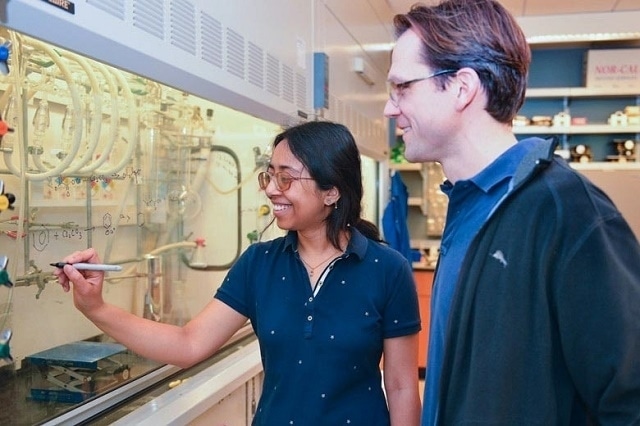Mar 10 2016
A new method to create plastic has been developed by Stanford scientists, using carbon dioxide (CO2) and inedible plant material, such as agricultural waste and grasses. This method could provide a low-carbon substitute to the existing petroleum-based plastic bottles and other items.
 Mark Shwartz/Precourt Institute for Energy
Mark Shwartz/Precourt Institute for Energy
The March 9 online issue of Nature published the results of the Stanford colleagues.
Our goal is to replace petroleum-derived products with plastic made from CO2. If you could do that without using a lot of non-renewable energy, you could dramatically lower the carbon footprint of the plastics industry.
Matthew Kanan, Assistant Professor of Chemistry, Stanford
The polymer Polyethylene terephthalate (PET, also called polyester), is used to make many plastic products. The global production of PET to create items such as; electronics, fabrics, personal-care products, and recyclable beverage containers is approximately 50 million tons. PET is made by using ethylene glycol and terephthalic acid, which are derived from natural gas and refined petroleum. PET production involves considerable quantity of CO2, which is a greenhouse gas and the cause of global warming.
The use of fossil-fuel feedstocks, combined with the energy required to manufacture PET, generates more than four tons of CO2 for every ton of PET that's produced.
Matthew Kanan, Assistant Professor of Chemistry, Stanford
For the study Kanan and his team concentrated on polyethylene furandicarboxylate (PEF), a promising substitute to PET. PEF is made of 2-5-Furandicarboxylic acid (FDCA) and ethylene glycol.
PEF is an attractive replacement for PET, because FDCA can be sourced from biomass instead of petroleum. PEF is also superior to PET at sealing out oxygen, which is useful for bottling applications.
Matthew Kanan, Assistant Professor of Chemistry, Stanford
Despite the desirable features, the plastics industry have not found a cost-effective method to mass produce PEF, the challenge is to discover a commercial and sustainable process for the production of FDCA.
One technique is to convert fructose, available from corn syrup, into FDCA. Avantium, a Dutch company, have been developing this technology with a partnership with Coca-Cola and other companies. But growing crops for industrial use needs large amount of land, water, energy and fertilizers.
Using fructose is problematic, because fructose production has a substantial carbon footprint, and, ultimately, you'll be competing with food production. It would be much better to make FDCA from inedible biomass, like grasses or waste material left over after harvest.
Matthew Kanan, Assistant Professor of Chemistry, Stanford
The Stanford group is following another route to make FDCA. It has been working with furfural, which is a product of agricultural waste and has been in wide use for decades. The yearly production of furfural is approximately 400,000 tons for use in solvents, resins and other products.
However utilizing CO2 and furfural to make FDCA requires using hazardous chemicals, which are themselves costly and energy intensive to make. "That really defeats the purpose of what we're trying to do," Kanan said.
The Stanford team resolved the issue by utilizing carbonate, a more benign compound. Aanindeeta Banerjee, lead author of the study, and a graduate student mixed carbonate with furoic acid, a derivative of furfural, and CO2. The mixture was heated to a temperature of approximately 290°F (200°C) so that a molten salt is formed.
The results were impressive. About 89% of the molten-salt mixture was converted to FDCA in 5 hours. According to Kanan, the next step was to transform the FDCA into the PEF plastic, this was straightforward as it had been worked out by other scientists.
The Stanford team's method can potentially reduce greenhouse emissions to a considerable extent, Kanan said, as the CO2 needed to produce PEF could be sourced from industrial sites and fossil-fuel power plant emissions.
Products made out of PEF can be reconverted to atmospheric CO2 or recycled by incineration. This CO2 can be used by weeds, grass, and other plants, all of which can be utilized to make more PEF.
We believe that our chemistry can unlock the promise of PEF that has yet to be realized. This is just the first step. We need to do a lot of work to see if it's viable at scale and to quantify the carbon footprint.
Matthew Kanan, Assistant Professor of Chemistry, Stanford
Kanan and his team have started to adapt the new chemical process to produce renewable fuels and other chemical compounds from CO2 and hydrogen.
That's the most exciting new application that we're working on now.
Matthew Kanan, Assistant Professor of Chemistry, Stanford
The other Stanford coauthors of the Nature study are graduate student Graham Dick and former postdoctoral scholar Tatsuhiko Yoshino, presently at Hokkaido University in Japan.
The research received support from the Stanford University through the Center for Molecular Analysis and Design, the Camille & Henry Dreyfus Foundation, and the Japan Society for the Promotion of Science.